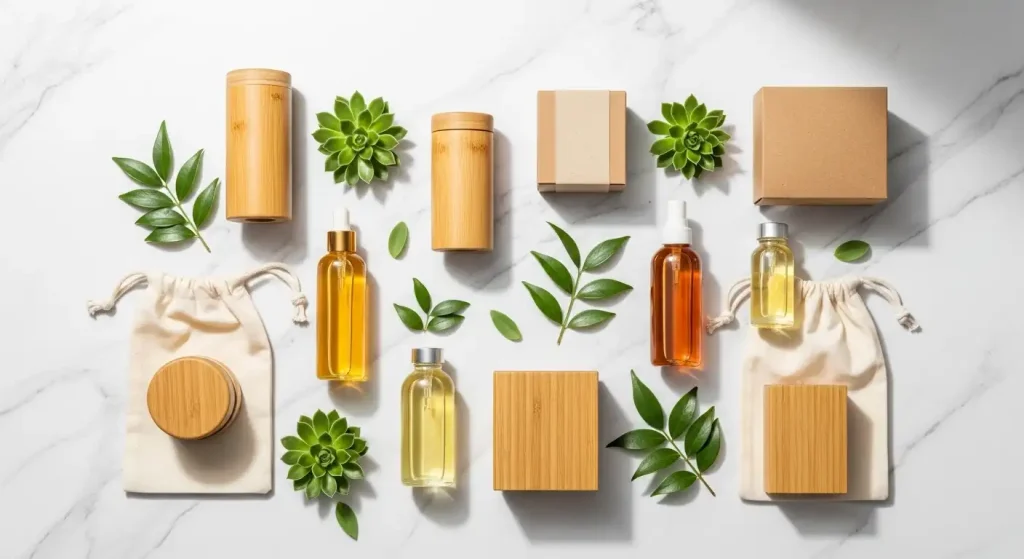The beauty industry is experiencing a revolutionary transformation as sustainable and clean beauty trends continue to dominate consumer preferences in 2025. This shift toward conscious cosmetics reflects growing awareness about environmental impact and ingredient safety, making clean beauty more than just a passing trend – it’s becoming the new standard.
What is Clean Beauty and Why It Matters
Clean beauty represents a movement focused on products formulated without harmful chemicals, synthetic additives, and toxic ingredients. Clean beauty is a key part of the shift toward Sustainable Beauty Trends in the skincare industry, focusing on creating products free from harmful chemicals, synthetic additives, and unnecessary fillers, prioritizing natural, safe ingredients that are gentle on the skin.
The sustainable beauty movement goes beyond clean ingredients to encompass environmentally responsible practices throughout the entire product lifecycle. From sourcing raw materials to packaging design, brands are reimagining how beauty products can be both effective and eco-conscious.
Top Sustainable Beauty Trends Shaping 2025
1. Wellness-Focused Beauty Products
In 2025, beauty products that promote overall well-being, such as adaptogenic creams, CBD-infused serums, and aromatherapy mists, will dominate. These products address stress, sleep, and mental health, acknowledging the connection between inner and outer beauty.
Key products driving this trend include:
- Adaptogenic skincare with ingredients like ashwagandha and reishi mushrooms
- CBD-infused beauty products for anti-inflammatory benefits
- Aromatherapy-enhanced cosmetics for mental wellness
- Probiotic skincare for microbiome health
Niacinamide vs Retinol: Which Anti-Aging Ingredient Reigns Supreme?
2. Zero-Waste and Circular Beauty
More and more beauty businesses are working to eliminate waste at every stage of production, with a focus on creating products that can be recycled, refilled, or reused. This includes:
- Refillable packaging systems that reduce single-use containers
- Biodegradable formulations that break down naturally
- Upcycled ingredients from food and agricultural waste
- Plastic-free alternatives using innovative materials
3. Transparent Ingredient Sourcing
Clean beauty brands are prioritizing transparency in their supply chains, offering consumers detailed information about:
- Ingredient origins and farming practices
- Fair trade certifications
- Environmental impact assessments
- Third-party testing results
Recovery Gear: Massage Guns vs Foam Rollers for Peak Performance
The Rise of Natural and Organic Ingredients
Trending Natural Ingredients in 2025
The demand for natural cosmetics has led to innovative botanical ingredients gaining popularity:
- Bakuchiol – A natural retinol alternative from the babchi plant
- Ceramides – For barrier repair and hydration
- Niacinamide – Vitamin B3 for multiple skin benefits
- Plant-based peptides – Sustainable alternatives to synthetic peptides
- Marine extracts – Sustainably sourced ocean ingredients
Sustainable Skincare Formulations
Modern sustainable skincare focuses on:
- Waterless beauty products to reduce environmental impact
- Multi-functional formulas that replace multiple products
- Concentrated formulations requiring less packaging
- pH-balanced natural ingredients for optimal skin health
Biohacking and Supplements for Peak Performance
Eco-Friendly Beauty Packaging Revolution
Innovative Sustainable Packaging Solutions
The beauty industry is embracing revolutionary packaging approaches:
| Packaging Innovation | Environmental Benefits | Examples |
|---|---|---|
| Solid beauty bars | No plastic packaging | Shampoo bars, cleansing bars |
| Bamboo containers | Renewable, biodegradable | Powder compacts, lip balms |
| Glass refill systems | Infinitely recyclable | Foundation bottles, serums |
| Compostable tubes | Break down naturally | Toothpaste, face masks |
Brand Leadership in Sustainable Packaging
Leading clean beauty brands are setting new standards with:
- Carbon-neutral shipping and production processes
- 100% post-consumer recycled materials
- Minimalist packaging design reducing material usage
- Take-back programs for container recycling
Green Beauty Brands Leading the Movement
Characteristics of Sustainable Beauty Brands
Successful eco-friendly skincare brands share common traits:
- Commitment to ingredient transparency
- Investment in sustainable sourcing
- Innovation in packaging solutions
- Support for environmental causes
- Third-party certifications (USDA Organic, Leaping Bunny, etc.)
HIIT vs Functional Training: Which Burns Fat Faster?
What to Look for in Clean Beauty Products
When choosing sustainable beauty products, consider:
- Certification labels indicating organic or cruelty-free status
- Ingredient lists with recognizable, natural components
- Packaging materials that are recyclable or biodegradable
- Brand values aligned with environmental responsibility
- Clinical testing proving efficacy without compromising safety
The Future of Conscious Cosmetics
Technology Meets Sustainability
The intersection of technology and sustainable beauty is creating exciting opportunities:
- AI-powered formulation reducing waste in product development
- Biotechnology creating lab-grown ingredients
- Smart packaging with QR codes for ingredient transparency
- Personalized beauty reducing overconsumption
Consumer Education and Awareness
The clean beauty movement is more than a trend; it’s a transformative force reshaping the beauty industry through innovation, transparency, and a commitment to sustainability and ethical practices.
Educated consumers are driving demand for:
- Detailed ingredient education
- Environmental impact information
- Sustainable packaging options
- Ethical brand practices
The Ultimate Guide to the Best Workout Apps and Online Classes in 2025
FAQ: Sustainable and Clean Beauty Trends
What’s the difference between clean beauty and natural beauty?
Clean beauty focuses on removing harmful chemicals and toxins from formulations, while natural beauty emphasizes plant-based and naturally-derived ingredients. Sustainable beauty encompasses both approaches while considering environmental impact throughout the product lifecycle.
Are clean beauty products as effective as traditional cosmetics?
Modern clean beauty products are formulated with advanced natural ingredients and sustainable technologies that often outperform traditional cosmetics. Many clean beauty brands conduct clinical trials to prove efficacy while maintaining safety standards.
How can I transition to a sustainable beauty routine?
Start by replacing products as they run out with clean beauty alternatives. Focus on multi-functional products, choose brands with sustainable packaging, and research ingredients to make informed decisions. Consider starting with basic skincare essentials like cleansers and moisturizers.
What certifications should I look for in sustainable beauty products?
Look for certifications such as USDA Organic, Leaping Bunny (cruelty-free), Fair Trade, B-Corp, and EWG Verified. These certifications ensure products meet specific standards for ingredient safety, environmental responsibility, and ethical practices.
Top Fitness Trackers & Smartwatches 2025: Ultimate Guide
Are sustainable beauty products more expensive?
While some sustainable beauty products have higher upfront costs, they often provide better value through concentrated formulations, multi-use capabilities, and refillable packaging systems. The long-term benefits to health and environment justify the investment for many consumers.
Make the Switch to Sustainable Beauty Today
Ready to transform your beauty routine with clean, sustainable products? Discover our curated collection of the best eco-friendly skincare and clean beauty brands that prioritize both your skin’s health and environmental responsibility
Organic skincare sets (OSEA, Youth To The People):
Shop sustainable beauty products with exclusive discounts and free shipping on orders over $50.











